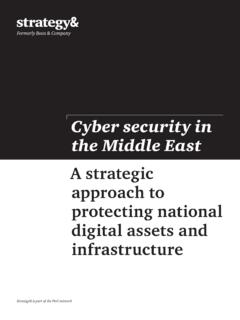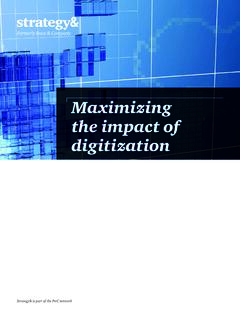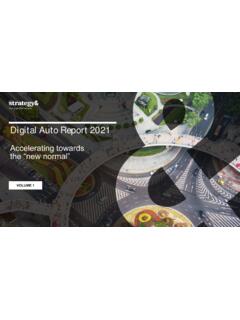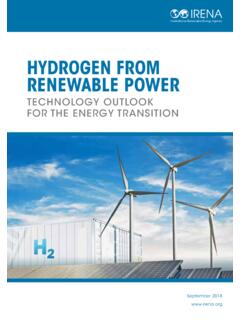Transcription of The dawn of green hydrogen - Strategy&
1 The dawn of green hydrogenMaintaining the GCC s edge in a decarbonized worldStrategy& | Skin in the game4 ContactsAbu dhabi Dr. Raed Kombargi Partner +971-2-699-2400 Beirut Dr. Yahya Anouti Partner+961-1-985-655 Ramzi Hage DubaiDr. Shihab Elborai Partner+971-4-436-3000 About the authorsDr. Yahya Anouti is a partner with Strategy& Middle East, part of the PwC network. Based in Beirut, he is a member of the energy, chemicals, and utilities practice in the Middle East. He specializes in resource-based economic development and energy economics.
2 He advises governments and oil and gas companies on sector strategies, operating models, and performance improvement Shihab Elborai is a partner with Strategy& Middle East. Based in Dubai, he is a member of the energy, chemicals, and utilities practice in the Middle East. He serves major electrical industry players across the Middle East and North Africa by redesigning strategy, policies, governance structures, and regulatory frameworks to navigate the shift from fossil fuels to renewables and to help build modern energy delivery systems. Dr. Raed Kombargi is a partner with Strategy& Middle East.
3 Based in abu dhabi , he leads the energy, chemicals, and utilities practice in the Middle East. He focuses on strategy development, concession agreements, commercial joint venture setup, cost reduction, operational excellence, capability development, and operating model assignments in the energy Hage is a principal with Strategy& Middle East. Based in Beirut, he is a member of the energy, chemicals, and utilities practice in the Middle East. He specializes in the renewable energy sector, with a focus on policy development, program establishment and execution, and manufacturing value chain localization.
4 Strategy& | The dawn of green hydrogen1 The global energy system stands at the threshold of a new era of abundance that will transform energy economics. Thanks to rapidly declining renewable energy costs and technological advances, hydrogen can become the medium of choice for transporting cheap clean energy across the globe. The COVID-19 pandemic has accelerated the trend toward decarbonization by reducing hydrocarbon demand estimates that global demand for green hydrogen , produced with minimal carbon dioxide (CO2) emissions, could reach about 530 million tons (Mt) by 2050, displacing roughly billion barrels of oil equivalent (around 37 percent of pre-pandemic global oil production).
5 We estimate that the green hydrogen export market could be worth US$300 billion yearly by 2050, creating 400,000 jobs globally in renewable energy and hydrogen hydrogen represents a promising opportunity for the Gulf Cooperation Council (GCC)1 countries. They can produce green hydrogen to boost domestic industries and for export. Although countries such as China and the are seeking to invest in green hydrogen , their export prospects are limited by large domestic demand that will probably consume most of their production. By contrast, GCC countries can export much of their green hydrogen and still have ample, low-cost renewable energy.
6 GCC countries need to act boldly to capture this prize with a three-phase plan:1. Launch a commercial -scale pilot in partnership with a leading electrolysis operating company to build capabilities and identify challenges, and start research and development (R&D). A single unit within an existing government entity should lead this effort. 2. Develop the right policies and regulations to support the domestic market, define the governance and institutional framework, and develop the funding Build the export infrastructure and secure supply agreements with key export SUMMARY1 The GCC countries are Bahrain, Kuwait, Oman, Qatar, Saudi Arabia, and the United Arab | The dawn of green hydrogen2 THE GROWING CASE FOR GOING green hydrogen , the world s most abundant and lightest element, has a wide range of industrial applications.
7 From refining to petrochemicals to steel manufacturing. It is also a rich source of energy, far more efficient than other fuels. hydrogen demand has been increasing at a steady pace over the past four decades (see Exhibit 1). The problem is that traditional means of producing hydrogen generate large volumes of CO2. Fortunately, advances in electrolysis technology and the falling cost of renewable energy are enabling the mass production of green hydrogen , which is more environmentally sustainable (see Three colors of hydrogen production ). These developments have altered the calculus for hydrogen and created a significant opportunity for countries to boost economic growth and move away from fossil Transport fuel, heat, and power were million tons in Strategy& : 2018 figures from International Energy Agency, The Future of hydrogen : Seizing today s opportunities, June 2019 ( ).
8 Strategy& analysisEXHIBIT 1 hydrogen demand is rising steadilyHydrogen demand (million tons)20 MethanolAmmonia1980502010281990432000311 51246220181 Refining2 SteelCAGR +3%Three colors of hydrogen production There are three main ways to generate hydrogen , represented by the colors gray, blue, and hydrogen . The most common process is to use either natural gas or coal as feedstock that reacts with steam at high temperatures and pressures to produce synthesis gas, which consists primarily of hydrogen and carbon monoxide. The synthesis gas is then reacted with additional water to produce pure hydrogen and CO2.
9 These are well-established processes, but they generate significant CO2 emissions, which is why the resulting element is termed gray hydrogen . Blue hydrogen . The second-most-common process, blue hydrogen , relies on the same basic processes as gray hydrogen , but it traps up to 90 percent of the greenhouse gas emissions through carbon-capture technology. In some cases, that carbon is stored underground, which requires considerable capital costs. Or it is reused as a feedstock for industrial applications, in which CO2 is still ultimately released into the hydrogen .
10 The most promising process, green hydrogen , uses renewable energy to power the electrolysis that splits water molecules into hydrogen and oxygen. Electrolysis requires energy. That this energy comes from lower-cost renewable sources is what makes this form of hydrogen green . There are three major electrolysis technologies with different levels of maturity. One technology, alkaline water (ALK), is the most basic and mature technology and has a market share of about 70 percent of the currently very small green hydrogen market. It benefits from low cost, and this process has a long operational life.









